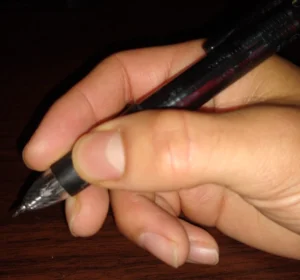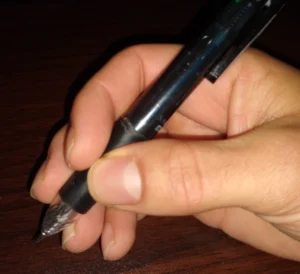While preparing for the IELTS test, you have so many things to think about. Is your English level high enough? Have you studied test format? Did you practice enough? All of these concerns can make your head spin! But have you ever though about how your handwriting might influence your band score?
Handwriting in IELTS is important to your success. If the examiner can’t read what you’ve written, they can’t accurately mark your work. Ensure you’re writing legibly.
Table of Contents
Is my handwriting really important?
Yes, it is! If you are sitting the paper-based IELTS test, you will need to write clearly and legibly. In situations where the examiner cannot read what you’ve written, it will be marked illegible and negatively impact your band score.
In these cases, your writing will not contribute to the word limit in the writing test. This can make it so your work is under the word limit required for the writing test (150 words in task 1 and 250 words in task 2). Additionally, in the listening and reading tests, illegible hand writing can turn a right answer into a wrong one. This is why it is vital that you write clearly during your test.
How to Write Clearly
If you’re concerned about the quality of your handwriting, there are a number of ways you can improve and ensure your writing is legible to your examiner on test day.
Use Good Materials
One of the fundamental aspects of good handwriting is using good tools. If your pencil or pen is of bad quality, it will be difficult for you to use it to write effectively. You don’t want to use a pen or pencil that feels uncomfortable to hold and keeps breaking or leaking ink. You already have enough to worry about during the test without your writing implements giving you problems as well!
Bring Your Own Pens and Pencils
The IELTS organization recommends using pencil during the test. This is because the test papers are scanned and pencil provides the clearest outline. This is not mandatory, however. If you prefer, you can write in pen as well. There is no set rule on the type of writing utensil you can use on the test.
If you forget to bring a pencil or pen, the testing center will provide you with a pencil. However, you want to make sure you don’t forget to bring your own. As mentioned above, you want to use materials you are comfortable using. The pencils provided by the testing center aren’t guaranteed to be of the best quality. So, you should bring your own pencils, pens, and erasers for your test day.
Don’t forget to bring extra. You never know when one of them might fail and you need another.
Clearly Mark Mistakes
If you’re using a pencil, it will be easy to correct any mistakes that you make. However, if you’re using a pen. This will not be possible (unless you’re using one of those fancy erasable ink pens)! Therefore, if you make a mistake while writing in pen, make sure you clearly mark the mistake. Draw multiple lines through the word or section you wish to delete. This signals to the examiner that they should not include these parts in their evaluation.
You don’t want your intentions to be ambiguous. If you want to correct yourself, mark it clearly.
Additionally, if you need to add forgotten words into sentences you’ve already written, use the caret symbol (^ or V) to indicate where the word should go in the sentence. Clearly marking your mistakes makes it easier for the examiner to evaluate your work. It’s important that the examiner is able to read what you’ve written. Otherwise, your band score will suffer!
Do you tend to make mistakes while writing? Looking for professional help with your IELTS writing test? Check out my IELTS writing correction and feedback service for personalized help!
Use Proper Spacing
In proper English writing, letters and words have spacing between them to improve clarity. You should maintain proper letter height and spacing so that your writing is clear for the reader.
If your letters are too close together, or you don’t put proper spacing between your words and sentences, it will be incredibly difficult for the examiner to read what you have written.
Practice proper spacing while you write. After you have written something, analyze your handwriting for mistakes. If you notice any malformed letters or spacing errors, focus on correcting them next time.
Do I have to Write in Cursive?

Cursive is a style of writing intended to be quick and easy for the writer to use. The letters connect and flow together. This makes writing faster than when using block letters.
Cursive writing used to be very popular when physically writing was an everyday activity. This type of writing used to be taught in schools. In fact, when I was a child, I had to learn how to cursive write. These days, however, writing with a pen or pencil isn’t as common as it was in the past. Schools no longer teach this skill because typing on a computer has become the dominant form of writing in the 21st century.
You don’t have to write in cursive in the IELTS test. If you don’t have this skill, don’t worry about it at all. In fact, some modern readers find it difficult to read cursive writing because it isn’t as widely seen anymore. You might want to avoid writing in cursive for your IELTS test for this reason.
How to Improve Handwriting.
So you know how to write clearly, but what if your handwriting is bad? What can you do to improve it?
Learn Proper Writing Techniques
Penmanship (clear handwriting) begins with good writing techniques. There are specific ways that you should hold your pen and move your wrist and arm in order to write clearly.
Hold Your Pen Properly
It might sound silly to say, but you might be holding your pencil wrong. Most people don’t even think twice about how they hold their pen or pencil while writing, but it’s generally agreed upon that there are two correct ways to grip a pen.
The first is between your thumb and index finger. The body of the pen will lay on your middle finger. (This is my preferred style.)

Another common way is to hold the pen with your thumb, index, and middle finger. The pen will lay on your ring finger.

Choose whichever style is most comfortable for you. It doesn’t matter which style you choose to hold your pen in. The key, however, is to be relaxed while holding the pen. There should be no tension in your fingers or hand.
Write With Your Arm
Most people commonly write using their fingers. This isn’t the recommended way to write, however. When you use your fingers to move the pen, it makes it difficult to write for an extended period of time. If your hand gets cramped and tired while writing, you know that you are writing with your fingers.
Instead, you should use your shoulder and arm to write. Your fingers should only be a guide for the pen. This will be less tiring, which will allow you to write for a longer period of time more consistently.
Focus on keeping your fingers, hand, and wrist still while moving the pen with your arm and shoulder. Instead of moving your hand to write more, move the sheet of paper down. This way you can avoid putting your hand into an uncomfortable position for writing.
Have Good Posture
It will be difficult to make proper use of your arm and wrist while writing if you are slouching in the chair. Make sure you sit up straight in a comfortable position. This will allow you to have full range of movement with your arm. You should be able to move it without any obstructions from your desk or chair.
Remember to remain relaxed and comfortable while writing. If you’re tensed up, your handwriting will become worse.
Focus on Your Writing
While you practice to improve your handwriting, you should focus on your lettering. Pay close attention to each letter as you write it. You could even say the letter out loud or in your head. Don’t worry about sounding strange or silly by repeating the letters you’re writing. You want to improve your handwriting, right?
After a while, you will become faster at writing and you won’t have to focus as heavily on each letter you write.
Practice
Daily practice is necessary in order to improve your handwriting. You are going to need to retrain your muscle memory. This takes a lot of work.
Focus on physically writing as much as possible. Copy sections out of books, write a journal, take physical notes. You should take any excuse available to write things out manually. While practicing for your IELTS writing test, write out your essays on paper as practice.
It might be time consuming, but if you dedicate some time every day to practicing your handwriting, you will be practicing your English skills and improving your handwriting at the same time!
Consider the Computer-based Test
If you’re still concerned about the quality of your handwriting, you should consider taking the computer-based test. There are a variety of positives to taking the IELTS test on a computer.
The first and most obvious benefit is you can type. Most people are comfortable typists these days. Typing on a computer has become a daily activity for most people. Therefore, most of us feel more comfortable typing rather than physically writing. If you’re a good typist, you should consider taking the computer-based test.
Another benefit is the ease with which you can alter your writing. In the paper-based test, if you make a mistake, you need to erase it and rewrite it manually. If you’re using a pen, you have to clearly mark the mistake and permanently mark up your paper. However, in the computer-based test, you can easily delete mistakes on a computer.
It’s also incredibly easy to reformat your work. If you don’t like the ordering of your paragraphs or sentences. It’s very easy to copy and paste them into your desired format. This, of course, isn’t possible on a paper-based test.
The computer-based test also keeps track of your word count while typing. This is a definite positive over the paper-based test. You don’t need to keep track of how many words you’ve written. Instead, the computer will do that for you, so you can focus on writing instead.
Conclusion
Clear handwriting is a vital component to receiving a high band score. You don’t want sloppy, unreadable writing to stand in between you and your goals. Therefore, it’s critical that you ensure that your handwriting is clear and legible. Otherwise, the computer-based test is always an option.
There are a variety of ways to improve your handwriting, but the most important one is practice. You should dedicate time to improving your handwriting daily. That way, when your test day arrives, you’ll be confident and ready to knock it out of the park!



